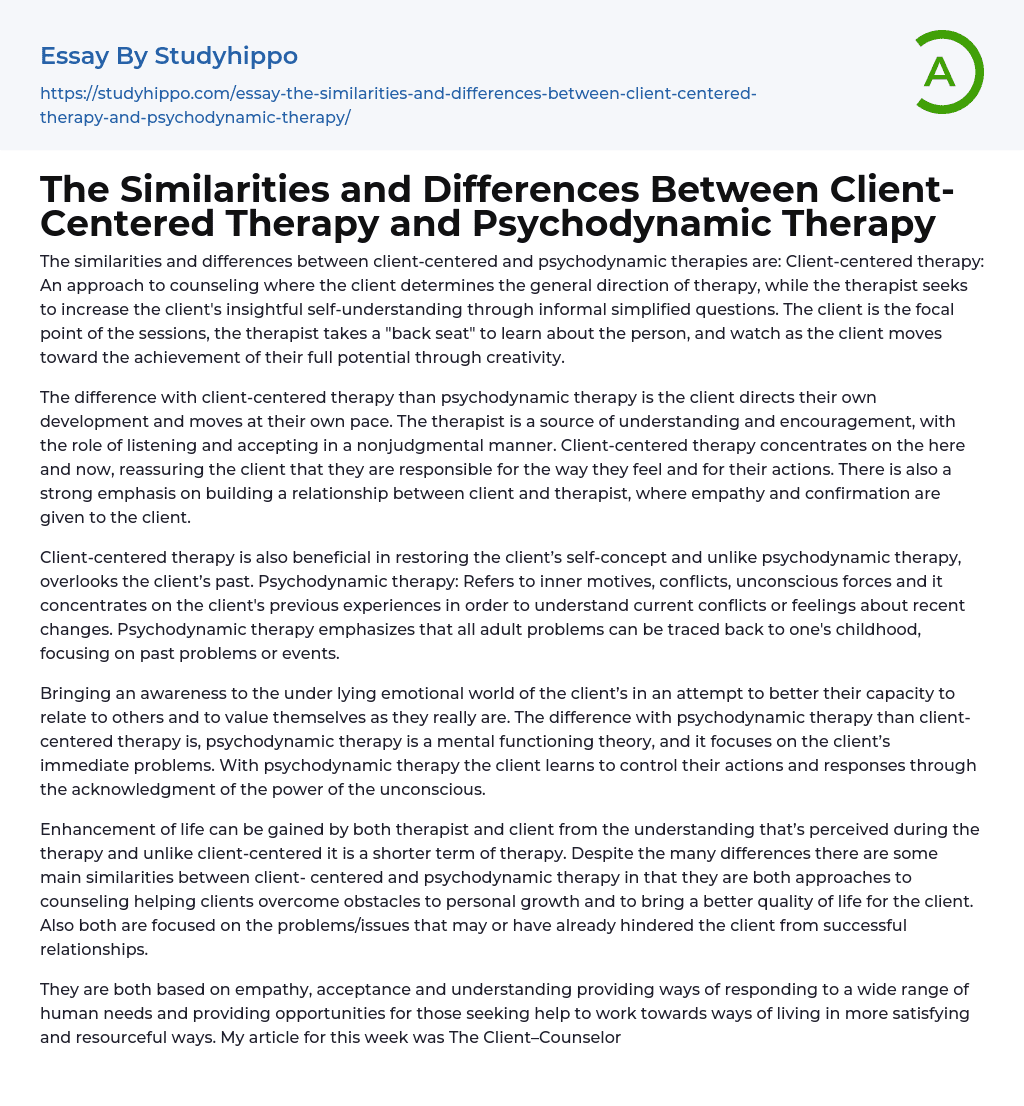The similarities and differences between client-centered and psychodynamic therapies are: Client-centered therapy: An approach to counseling where the client determines the general direction of therapy, while the therapist seeks to increase the client's insightful self-understanding through informal simplified questions. The client is the focal point of the sessions, the therapist takes a "back seat" to learn about the person, and watch as the client moves toward the achievement of their full potential through creativity.
The difference with client-centered therapy than psychodynamic therapy is the client directs their own development and moves at their own pace. The therapist is a source of understanding and encouragement, with the role of listening and accepting in a nonjudgmental manner. Client-centered therapy concentrates on the here and now, reassuring the client that they are responsible for the way they feel and for their actions. There
...is also a strong emphasis on building a relationship between client and therapist, where empathy and confirmation are given to the client.
Client-centered therapy is also beneficial in restoring the client’s self-concept and unlike psychodynamic therapy, overlooks the client’s past. Psychodynamic therapy: Refers to inner motives, conflicts, unconscious forces and it concentrates on the client's previous experiences in order to understand current conflicts or feelings about recent changes. Psychodynamic therapy emphasizes that all adult problems can be traced back to one's childhood, focusing on past problems or events.
Bringing an awareness to the under lying emotional world of the client’s in an attempt to better their capacity to relate to others and to value themselves as they really are. The difference with psychodynamic therapy than client-centered therapy is, psychodynamic therapy is a mental functioning theory, and it focuse
on the client’s immediate problems. With psychodynamic therapy the client learns to control their actions and responses through the acknowledgment of the power of the unconscious.
Enhancement of life can be gained by both therapist and client from the understanding that’s perceived during the therapy and unlike client-centered it is a shorter term of therapy. Despite the many differences there are some main similarities between client- centered and psychodynamic therapy in that they are both approaches to counseling helping clients overcome obstacles to personal growth and to bring a better quality of life for the client. Also both are focused on the problems/issues that may or have already hindered the client from successful relationships.
They are both based on empathy, acceptance and understanding providing ways of responding to a wide range of human needs and providing opportunities for those seeking help to work towards ways of living in more satisfying and resourceful ways. My article for this week was The Client–Counselor Match and the Corrective Emotional Experience: Evidence from Interpersonal and Attachment Research written by Annie Bernier and Mary Dozier from the University of Delaware.
The article suggest the client-counselor match as a helping condition for a healing emotional experience and revisits the appropriate facts from attachment and interpersonal studies. In reading the article this week I believe it does lend validity to client-centered therapy, with client-centered therapy, the therapist and client must have a building relationship, understanding and a meeting of the minds so to speak.
It is generally recognized that the client–counselor match is an important predictor of successful therapeutic relationships (Berzins, 1977; Beutler, 1991; Reis ; Brown, 1999). Beutler (1998) made the conclusion that after a
review of variables contributing to the outcome of therapy, that the therapist- client match was the strongest outcome of predictors. The article also read that counselor and client similarities on beliefs, coping, personal values, attitudes and expectations toward counseling has also been linked to the outcome of positive treatment (Tally et al. 1990). According to the statistics provided in the article performed by (Beutler, 1991) At least 175 categories of client characteristics and 40 therapist traits have been studied as potential predictors of treatment effectiveness and it has been suggested that the client–counselor match accounts for a greater portion of the outcome than does any single characteristic of the client or of the counselor. REFRRENCES: Corsini, J. R. amp; Wedding, D. (2011). Current Psychotherapies. Ninth Edition, Belmont, CA. Brooks/Cole, Cengage Learning. Coon, Dennis (2003). Essentials of Psychology. Ninth Edition, Belmont, CA. Wadsworth/Thomason Learning Bernier, Annie ; Dozier, Mary, University of Delaware (2002). Psychotherapy: Theory/Research/Practice/Training, Educational Publishing Foundation, (2002), Vol. 39, No. 1, 32–43 Jacquelyn Brown-Bullock Psychology/Counseling
- Anatomy and Physiology essays
- Addiction essays
- Biodegradation essays
- Dental Care essays
- Disease essays
- Disorders essays
- Health Care essays
- Intelligence Quotient essays
- Nutrition essays
- Olfaction essays
- Public Health essays
- Women's Health essays
- World health organization essays
- Cancer essays
- Infectious Disease essays
- Lung Cancer essays
- Neurology essays
- Physical Exercise essays
- Medicine essays
- Sex essays
- Inquiry essays
- Disability essays
- Poison essays
- Action Potential essays
- Nervous System essays
- Childbirth essays
- Puberty essays
- Blood essays
- Kidney essays
- Neuron essays
- Body essays
- Glucose essays
- Sense essays
- Heart essays
- Skeleton essays
- Human Physiology essays
- Eye essays
- Immune System essays
- Muscle essays
- Skin essays
- Brain essays
- Central Nervous System essays
- Human Skin Color essays
- Digestive System essays
- Common sense essays
- Respiration essays
- alcoholism essays
- Smoking essays
- Casino essays
- Tobacco essays




